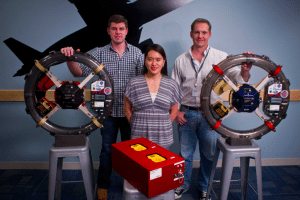University’s Electromagnetic Propulsion Technology Expands Possibilities for Satellite Positioning

The RINGS Team. (Pictured left to right) Graduate students Dustin Alinger and Allison Keong Porter, and Associate Professor Ray Sedwick.
Image Credit: University of Maryland’s Clark School of Engineering
[Via Satellite 08-20-13] New electromagnetic propulsion technology being tested by the University of Maryland’s Space Power and Propulsion Laboratory (SPPL) on the International Space Station (ISS) could change the capabilities of satellites and future spacecraft by reducing reliance on propellants and extending the lifecycle of satellites through the use of a renewable power source.
Associate Professor of Aerospace Engineering Ray Sedwick and his research team have been developing technology that could enable electromagnetic formation flight (EMFF), which uses locally-generated electromagnetic forces to position satellites or spacecraft without relying on propellants. Their research project is titled Resonant Inductive Near-field Generation System, or RINGS.
RINGS is composed of two units, each of which contains a specially fabricated coil of aluminum wire that supports an oscillating current of up to 18 amps and is housed within a protective polycarbonate shell. Microcontrollers ensure that the currents oscillate in-phase or out-of-phase to produce attracting, repelling and even shearing forces. While aluminum wire was chosen for its low density in this research prototype, eventual systems would employ superconducting wires to significantly increase range and performance.
The project was sent to the ISS on August 3 as part of a payload launched on Japan’s HTV 4 Cargo Ship from the Tanegashima Space Center. Astronauts will unpack the equipment, integrate it into the test environment and run diagnostics. From there, RINGS will undergo three science research sessions where data will be collected and transmitted back to the ground for analysis.